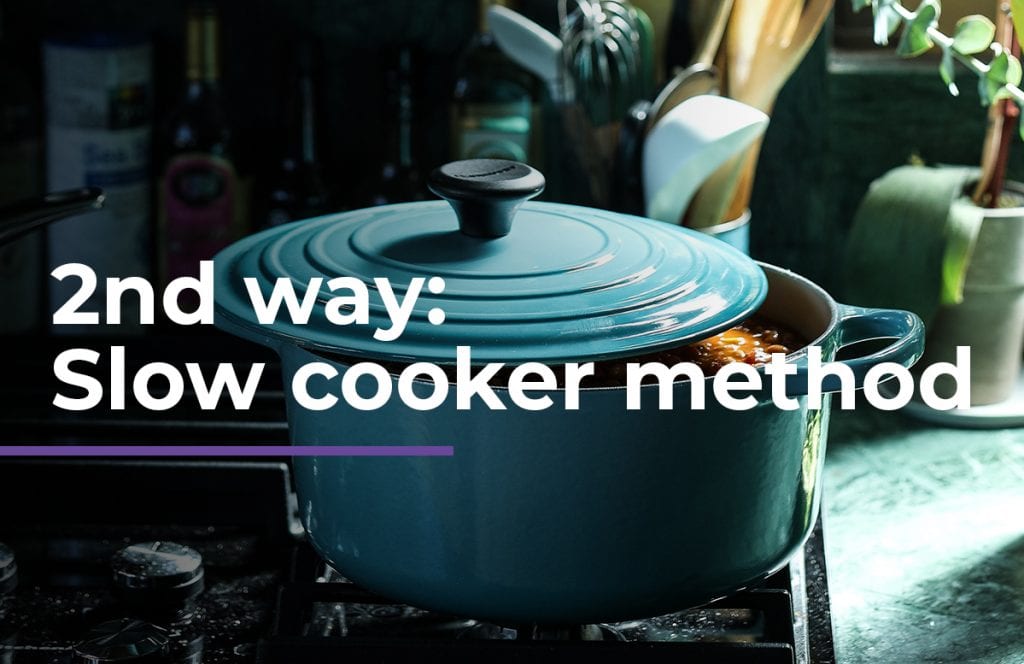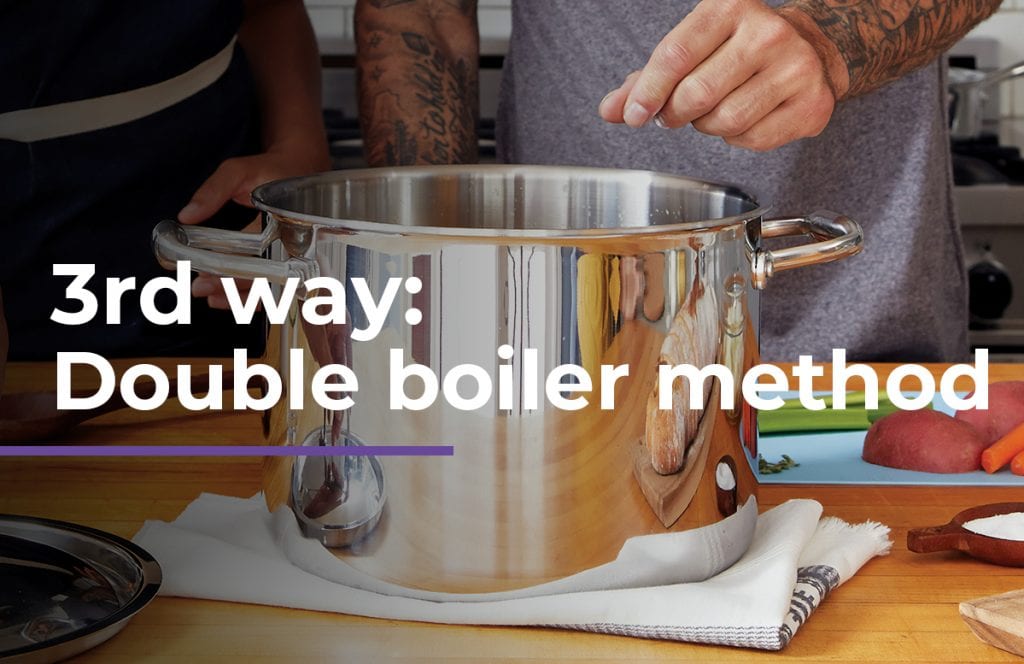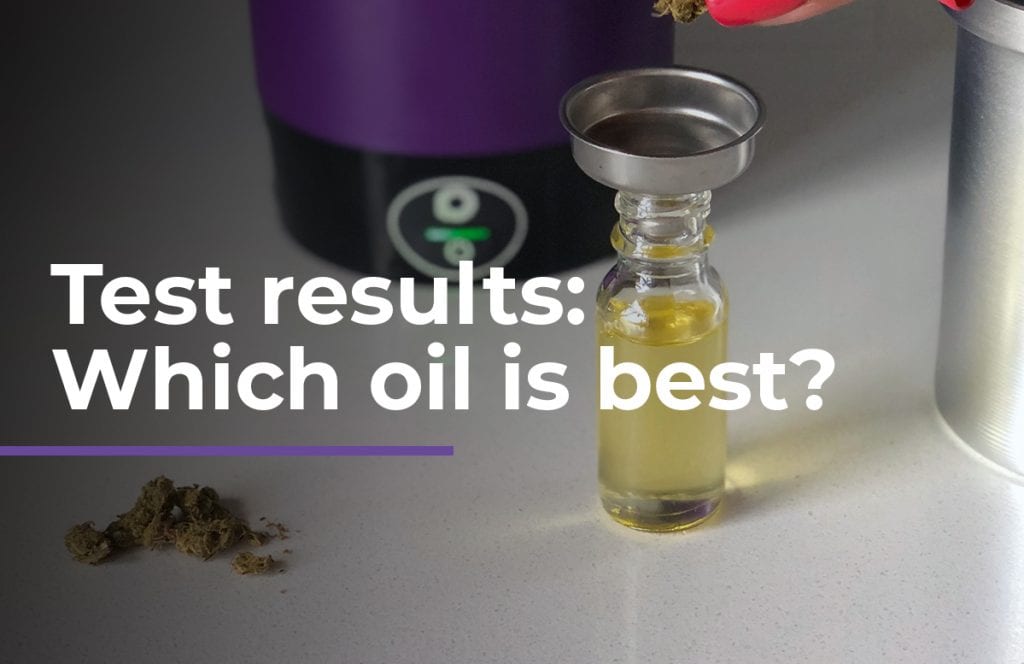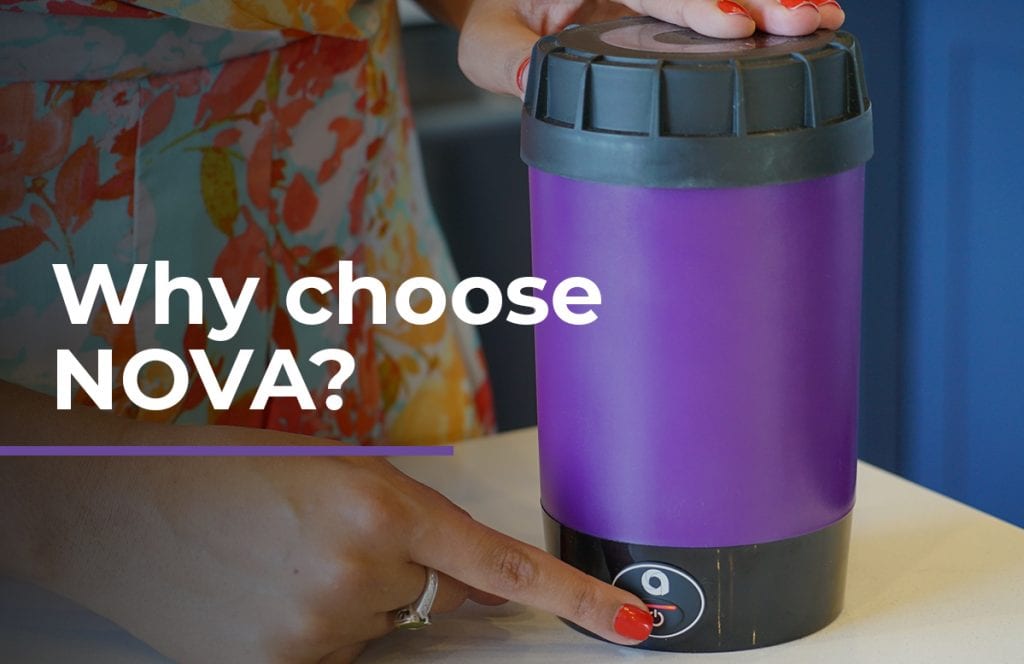Now that you’ve learned how to decarb weed, you’re ready to tackle cannabis oil infusions. Learning the information is the first step in your journey of learning how to infuse cannabinoids (or just your new favorite method). There are many ways to combine your plant material with fats like oil, butter, and ghee, to make your infused treats even tastier and more bioavailable than ever before.
Once your medical marijuana is decarboxylated, fats and oils act like insulators to your cannabis flower, and can typically undergo a bit more heating before fully binding with the cannabinoids and terpenes in your plant material. This guide will help you go from stovetop to the final product in no time.
TABLE OF CONTENTS
3 Ways to Make Cannabis Infused Oil
- Nova Decarboxylator
- Slow Cooker Method
- Double Boiler Method

1. Nova Decarboxylator
That’s right! You can now infuse cannabis right inside the NOVA. Watch our how-to video here.
Storing your cannabis flower in a cool, dark place before or after decarb is the first step to maximum potency. When exposed to excessive heat over long periods of time, degradation of plant material begins to occur, which may result in a weaker end product.
- Decarboxylate your cannabis.
Decarbing in the Nova results in a full decarb, every time. Skill level required: beginner to pro. - Place the decarbed cannabis into a glass jar of butter or oil, or use our Concentrate and Infusion Sleeve for a perfect fit in your Nova!
- Put the jar back into the decarboxylator for a second cycle. The second cycle will pull the THC or CBD from the plant and infuse it into the oil.
- When the process is complete, strain the plant material from the oil.
- The infused butter or oil can then be used to make any cannabis product, including THC and CBD oils and tinctures, gummies, brownies, and other edibles or giftable cooking oils.

2. Slow Cooker Method
Many folks opt for the slow cooker or crockpot method because it can help infuse your medical cannabis over low heat for over an extended period of time. This method is also called the water bath method.
- Decarb the Cannabis
Decarbing in the crockpot results in, at most, a 70% decarb and will vary from batch to batch. Skill level required: intermediate to pro. To decarb in the crockpot or slow cooker, you must place your plant material in a water bath, preventing the temperature from going over water’s boiling point of 212 degrees Fahrenheit. You can use a mason jar to shelter the cannabis buds from the water. The crockpot method is great for maintaining temperature stability but fails to fully and effectively activate all available cannabinoids due to its inability to go beyond 212 degrees leaving it unable to achieve a full decarb. - Select your Oil
When using this method, a thick fat like butter, olive oil, or coconut oil usually makes the most sense for your infusion. - Heat
Add your decarboxylated cannabis, butter, and water to the crockpot mixture, and allow it to sit over low heat (adding more water, if necessary) and infuse for 2 hours. - Strain
Strain out your plant material, using a cheesecloth, coffee filter, or the Ardent Frainer (our funnel/strainer hybrid,) and discard.

3. Double Boiler Method
Double boilers are useful tools for melting chocolate and working with other sensitive materials, like butter and milk, that can easily scorch. Many patients also utilize double boilers to create concentrates but we will focus on butters and oils today.
Like the crockpot method, the double boiler method helps maintain a layer of protection from direct heat; however, you’re limited to the temperature of boiling water, which can only reach 212 degrees F. The double boiler method also comes with intrusive aromas and fluctuating temperatures due to exposure to direct air throughout the infusion process, impacting the strength and quality of your final product.
- Decarb cannabis using a slow cooker, stove, or for maximum efficiency use the Nova decarboxylator
- Combine oil and plant material in the double boiler
- Pour the oil or butter of your choice in the double boiler with your plant material
- Place Mixture Over Medium Heat
Allow the oil and cannabis mixture to infuse over medium heat for 90 minutes, occasionally stirring. - Strain and store
- Remove double boiler from heat. Using a cheesecloth, strainer, or the Ardent Frainer, our funner/strainer hybrid, separate your plant material from your infused oil and dispose of the used material. Store your infused oil in an airtight container like a tincture bottle, and enjoy it as is, or as an ingredient in the recipes of your choice.
But wait…there’s more! Test results show how to infuse cannabinoids
Much like the decarb process, there’s a lot of mystery surrounding cannabis infusion. This is mainly due to the lack of data regarding the infusion process – there’s little to no real testing to show the maximum amount of THC you can get into butter or oil infusions.
We set out to change that by bringing in MCR Labs to test a number of infusion samples extracted using the Nova. We were excited with the results.

Will infusing decarbed herb damage the THC?
When you add the decarbed flower into the fatty oil, the oil encapsulates the flower, acting as an insulator.
That’s why it’s necessary to decarb BEFORE you infuse.
The oil acting as an insulator means that you won’t get a fully activated product if you don’t decarb before the infusion process.
Our testing below shows the infusion of flower that was NOT decarboxylated prior to infusion. The flower was mixed with oil and placed in the decarboxylator.
| | ACID THCA | ACTIVE THC | TOTAL POTENTIAL ACTIVE THC | TOTAL INFUSION % | DECARB % | TESTING RESULTS |
|---|---|---|---|---|---|---|
| Sample A: 1 gram of Raw Plant – Gorilla Glue | 170mg | 18mg | 168mg* | | 10% | View Results |
| Infusion A: 1 gram of raw plant Gorilla Glue infused in NOVA with 1 oz coconut oil with no pre decarb | 98mg | 47mg | 136mg* | 80% | 33% | View Results |
| Sample B: 1 gram of Raw Plant – Red Congo | 206mg | 13mg | 193mg* | | 6% | View Results |
| Infusion B: 1 gram of raw plant Red Congo infused in NOVA with 1 oz Grapeseed oil with no pre decarb | 143mg | 35mg | 159mg* | 82% | 22% | View Results |
*Total Potential THC = THCA x .87 + THC. When THCA converts to THC the acid molecule (carboxyl group) is released, reducing the total molecule weight by 13%. Thus, you can only get the full potential THC with precision decarboxylation.
- View MCR Labs test results for 1 gram of Raw Plant
- View MCR Labs test results for infusion of 1 gram of Raw Plant
While there was good infusion into the oil (80%), you can see the vast majority of the cannabinoids are still in the acid THCA form (almost 100mg). This means that when using this oil, instead of getting the effects of the expected 130mg dose of THC, you would only get 47mg.

What’s the best oil to infuse THC or CBD?
We tested several types of oils to figure out which type of oil produced the highest THC levels after infusion.
Details of the test:
Starting flower for all of the infusions was 20% THC after precision decarb in the Nova. That means in each gram of starting material, there was 200mg of THC. See our guide on how to measure THC for more details on dosing after decarboxylation.
In the table directly below, 2 grams of decarbed flower totaling 400mg of THC was placed inside a glass container with 1 ounce of oil and infused for 1 cycle. The testing results below show how much of the 400mg were pulled into the ounce of oil during the infusion.
| TYPE OF OIL | AMOUNT OF DECARBED FLOWER PLACED IN 1 OZ OIL | TOTAL MG THC EXTRACTED INTO 1 OZ OIL | INFUSION PERCENTAGE | LINK TO TESTING RESULT |
|---|---|---|---|---|
| Extra Virgin Olive Oil | 2 g – 400mg | 392mg | 96% | View Results |
| Fractionated Coconut Oil | 2 g – 400mg | 332mg | 81% | View Results |
| Walnut Oil | 2 g – 400mg | 370mg | 91% | View Results |
Choosing a good oil for the infusion isn’t too difficult. Every oil we tested had an infusion rate of 80% or higher, and some over 90%. Keep scrolling to see infusion percentages of more oils and information on increasing and decreasing the potency.
Check them out:
Decarbed Flower 20% THC ~ 200 milligrams per gram of flower (200mg/g) View Results
- View MCR Labs test results for Extra Virgin Olive Oil
- View MCR Labs test results for Fractionated Coconut Oil
- View MCR Labs test results for Walnut Oil

How to make canna oil more potent
Changing the potency is a matter of adding additional cannabis. You can use as little as a half a gram of flower. For those who need a higher dose, just increase the amount of cannabis.
Flower to oil ratio is another question we get all the time. We were able to get up to 700mg in an ounce of oil out of a total of 800mg (4gm) of flower material.
That was the highest saturation point for this particular strain of flower in one ounce of oil (though you could get higher using more potent flower, concentrate or kief).
| TYPE OF OIL | AMOUNT OF MATERIAL PLACED INTO 1 OZ OF OIL | TOTAL MG EXTRACTED INTO 1 OZ OIL | INFUSION % | |
|---|---|---|---|---|
| Butter | 0.5 – 100mg | 93mg | 93% | View Results |
| Avocado | 0.5 – 100mg | 92mg | 92% | View Results |
| MCT | 0.5 – 100mg | 91mg | 91% | View Results |
| Grapeseed | 1g – 200mg | 163mg | 81% | View Results |
| MCT | 4g – 800mg | 707mg | 87% | View Results |
| Coconut | 4g – 800mg | 670mg | 82% | View Results |
| Walnut | 4g – 800mg | 679mg | 83% | View Results |
| EVOO | 4g – 800mg | 675mg | 83% | View Results |
*Dosing with edibles should start low (5mg) and then titrate up 5mg per 2-3 hours after your last dose to test and reach the appropriate dose. Most legal states limit dispensary doses to 10mg per dose, with 10 servings (100mg) per package. Patients using cannabis for severe pain relief may need to use more than 100mg per day.
Can you increase potency with kief or concentrates?
Follow the same procedure: decarb the kief or concentrate first, then mix with your butter, oil, or ghee to infuse.
However, you can choose whether you want to strain the kief out, or leave it inside. If you plan to strain, put the material through an entire infusion cycle to make sure the maximum amount infuses into the oil. Then, using a cheesecloth, coffee filter, or the Ardent Frainer (our funnel/strainer combo) separate your plant material from the oil. Otherwise, simply stir. With concentrates, it’s really more of a mixing process than an infusion process (concentrates will blend with the oil; there is no straining necessary or even possible).
After decarbing the concentrates, you can mix it with the oil and put it back in the decarboxylator for another 30 minutes, to allow the contents to heat and blend.

Cannabis Infused Oil Summary
The Ardent decarboxyaltors are the most easy, mess-free, and effective way to decarboxylate and infuse cannabis into butters and oils at home. Through our research with MCR Labs, we’re able to put older methods and new technology to the test, providing consumers with scientifically-backed proof for all of their holistic kitchen experiments. Happy infusing!
Perfect Decarb and Infusion in One
Activate and Infuse your THC with the Nova Lift Home Decarboxylator.

Questions? Comments?
We love to hear from you guys, please drop us some comments below or visit us on our instagram so we can find out – we’ll be answering them all!








Hi – I decarb then extract with 200proof organic grain alcohol (which then evaporates naturally, safely outside). The gooey, dark remains my now only effective medicine.
Thanks for product – I have referred you many people! What the “stores” have (legal/medicinal etc.) is just too compromised in quality or communication/knowledge of product.
You are doing a great service!
This is great!
YOU STATE After decarbing the concentrates, you can mix with the oil and put it back in the decarboxylator for just 30 minutes, to allow the contents to heat and blend well.
Does that mean its ok to turn off the power 30 mins into the cycle with no harm to the machine?
Absolutely 🙂 If you need to turn off your unit mid-cycle, simply hold down the main button for 15-20 seconds. Once the light has turned from red to green, the unit has turned off.
would there be a difference in the high if i used a sativa or indica or even a hybrid?
Each cannabis type (sativa, hybrid, indica), and more importantly strain, will have its own profile when it comes to effect which will translate into your infusions as well. For example, when you infuse a sativa flower into oil, you will end up with a “sativa-oil”!
Making any product strain-specific is a pretty awesome benefit of infusing in your NOVA, and one our team loves to utilize in our own lives 🙂
This is great news. I have been using my NOVA to decarb, then using the Mighty Fast Herbal infuser to make oil, butter and recently tintcher. That has been working fine, except you have to prepare quite a bit each time you use it. I’m looking forward to using the NOVA for both steps, using smaller amounts to experiment…. glad it’s my day off ☺
Thanks for all the great info.
Lori
I am SO excited to try to make more oils. I have been wanting to try something new and I already love my NOVA as it is. Can’t wait to infuse it as well!!
Thank you for the awesome educational material and product!
So great to have such attention and quality given to the home user/ individual.
I really liked the glassware, funnel and screen set used in the video – possible you have a link to where that can be bought?
Best purchase i ever made regarding cannabis. Wish i had known about it years ago.
This is very exciting and looking forward to trying, definitely makes this product more versatile and accessible!
Shanel thank you for the NOVA!
Hi,
I just bought my own NOVA and can’t wait to try it out!!
I am a medical patient & have been using your product for several years. I love you Ardent. I have some life altering health issues that respond well to cannabis. My infused medicines have become stronger while using less plant material. Best money I ever spent. Stay NOVAed!
I think I have this thing figgered out 😉
Dry herb – I just decarb then grind, and weigh out doses. I just mix it in food as is.
Also, I like butter! I found the easiest way is to use keif (for butter or oil) I also found that the dosing is more important than the butter amount. Easier to have more potent, small doses than to have to use ALOT of butter for a regular dose. You can always add plain butter to the dish if needed.
Quick clarified butter – bring just to simmer. When milk-fats start to rise, add a small spoon of corn starch and whisk it in. It binds to the fat, and you can strain it immediately. 1 stick (8tbsp) yields about 7tbsp clarified.
Guessing the keif at 70% 1g = 700mg. So no matter how much butter you use, if you divide it into 14 even doses, each is 50mg. 1 stick of butter clarified leaves about 7tbsp. See the math getting easy?
A silicone mold with 12-15 compartments works great, and I use a large (turkey injector) syringe to fill them to prevent loss – this is strong stuff LOL. Lastly, because it is potent, I put a kettle of water on, then rinse of my utensils into the pan, and scrape the edges and bottom of the pan. Oil (butter) floats. Put it in the fridge and let it solidify.
Hope this helps.
I live in a state where it’s still taboo to use.
( Idaho) anyway a lot of people follow me online. I would love to review your product for patient’s still viewed as outlaws.
I wasn’t sure how to decarb & infuse hash in my Ardent, so I dropped a quick mail to the support guys. Quick answer to confirm that I can, and a link to this helpful page. WELL DONE ARDENT! My Hash oil infusion is powerful and suits all my medicinal needs, thanks to the Lift 😉
I think this is a great thing I’m so interested in purchasing!
How do I find previous questions and reply’s?
Great! Thanks for sharing !
It’s actually a cool and helpful piece of info. I am satisfied that you simply shared this helpful information with us. Please keep us informed like this. Thanks for sharing.|
Thanks for writing this. I learned alot
This machine couldn’t be simpler to operate, does what it says, and saves me tons of cash. I can’t say a big enough THANK YOU !
That’s fabulous info thx
This thing is fantastic. It does what it says. You literally put your stuff in, push one button and wait. A couple of hours later really powerful medicine comes out. Accurate dosing is super easy. I use olive oil and draw it up in oral syringes so I can dose accurately to the mg. Great for if you have a newbie trying some so you don’t knock them out accidentally.
The main selling point for me selling is the potency of medication you can make. Price per mg thc for commercial edibles is insane and the potency is so low I’d have to eat entire bags of gummies to get anything going. With the lyft, you can get hundreds of mg thc into a few millilitres of oil and the cost per mg thc is way lower. If you’re using weed as medicine this is an invaluable tool.
I am totally happy with the wonderful results I have obtained with my Ardent. I have saved the cost of the device many times over in producing my own medicine. I also use my Ardent to produce the CBD Oil I take each morning and evening. I choose fine Hemp that has been cultivated then harvested and aged and bottled for a time then lab tested. I make it using just pure EVOO adding a tablespoon of virgin coconut oil per ounce. So I do the FECO at night and the CBD morning and night. This product is a time and money saver as well as a way to control my intake of medicine.
Just got my device today and have started to process lower grades strain at first. Just to test. This thing is brilliant! Very impressed. Thank You Ardent.
Can the infusion sleeve be used to make an alcohol-based tincture?
Sorry, I’m still a little confused.
Are the steps: 1. decarb concentrate 2. Infuse concentrate with oil. 3. decarb flower 4. infuse flower with concentrate infused oil?
No problem, I am happy to help. In these steps, you would most likely not need to decarb both concentrate and flower. You can start with 1. Decarb concentrate OR flower and
2. Infuse oil with (decarbed) concentrate or (decarbed) flower. The next optional step, if you used flower, would be to strain the flower out of the oil (to help with this, you could use our Frainer –https://ardentcannabis.com/product/frainer-funnel-strainer/). For concentrate, there would be nothing to strain since the concentrate would have melted and mixed into the oil completely.
I’ve made ghee from butter, by removing the milk product as the butter simmers.
Side to side comparison, the ghee is always more potent. I’m curious how the ghee would affect the infusion percent, and what the outcome would be with the nova.